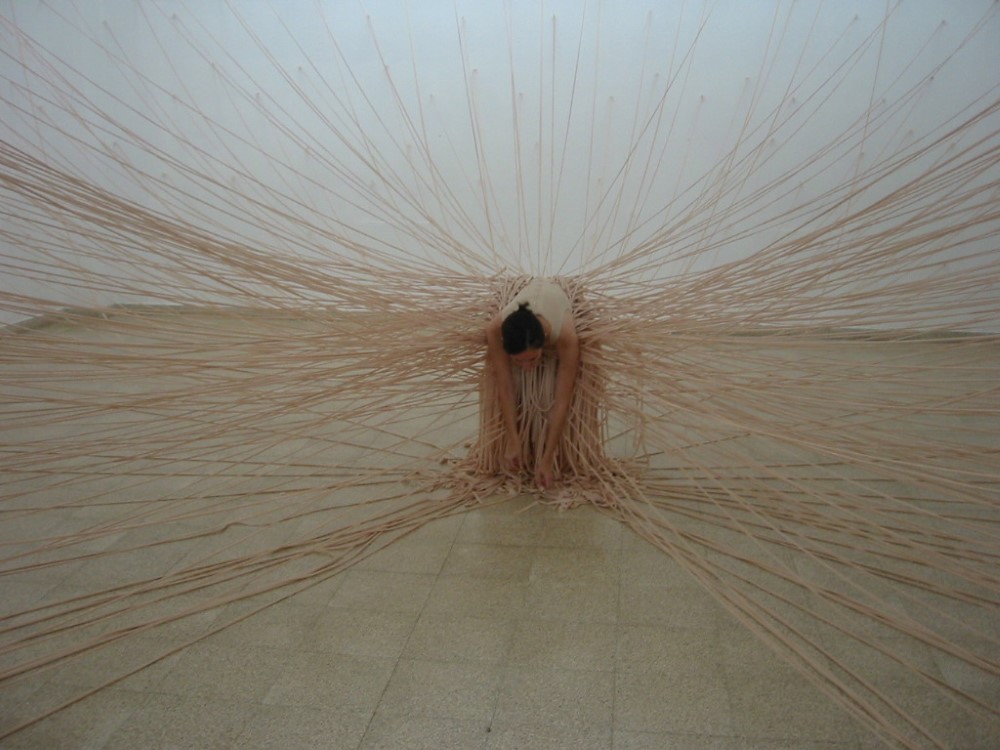
Nelly Agassi operates in the fragile realm between the neural, sensitive interior and the spatial, public exterior. She exposes a delicate texture of inner signals, whether voluntary or involuntary, in an inner frequency without a verbal language.
At present, in a battered and bruised society whose skin is thick, Agassi searches for the inner pulse, aiming at the intimate, fine beat of the private.
Before a sensitive, indifferent, controlled or accidental audience, she is absorbed in her own action, traversing one by one the skin covering, the garment, the built-up space, the social ritual. She does so through practice devoid of pathos, ideology or floridity. In the exposed public sphere she weaves a mundane choreography comprised of ordinary, daily acts of tying, sewing, wrapping, cutting. It is always the act of an individual, disciplined, efficient, following an inner rhythm, repetitious, exhausting, suggestive. The language is economical, direct, bare. What is more direct that the body and more touching than its means of protection that expose its vulnerability?
The body is Agassi’s scene of action, and she combines performance with fiber-work, choreography with installation and video pieces. The diverse fields of activity do not dim the kernel of her work. She examines the points of friction between the private and the social, the intimate and the public, the fluid, vulnerable interior and the unknown expanses of the exterior.
Agassi’s engagement with pain is exact and exacting. She avoids both self- and social mythology. The frugal, sensuous language allows for inner evolution of an image that offers a personal narrative.
It is not easy to be accurate in such a sensitive field, all the more so when it concerns a work that gathers its strength from internal, suggestive sources. Agassi is not interested in a wild expressive or “authentic” act. She refines the modes of action that enable her to entwine inner work processes without them getting out of hand. She does so by dividing the work process in two. A first meticulous planning phase defines a conceptual dimension and shapes a clear temporal and spatial frame. This preliminary stage, which also includes analytical and rational elements, allows the time of the event, the suggestive act in all its force, without waiving the principal position that demands simplicity and punctuality.
For many years, the narrative of Israeli art has pushed aside the private preoccupation with the body, supplanting it with a metaphorical affinity to the body of the nation, the land, and a sensual perception of the landscape. In a demanding society, where private pain has been channeled into the collective domain, the voice of artists articulating the fragile private existence was seldom heard.
It was artist Aviva Uri who in 1958 created a series of drawings entitled The Acrobat in frugal and intimate language, pencil on paper. She portrayed the figure of the woman in the circus, who performs before an audience a precise existential art hanging on a thread; the woman who hovers between heaven and earth, on a rope attached to the wall and above a net stretched in the air.
In Nelly Agassi’s work, a skin-colored dress floats at the center of the hall, and thin ribbons, like bodily threads, are sent out into the surrounding space of the white walls, maintaining a fine balance between hovering and entrapment. When Agassi squeezes into the dress-envelope, the garment is filled with life and a shudder goes through the threads, affecting the entire space.
Nelly Agassi
Palace of Tears
Curator: Hadas Maor
May-August 2002

